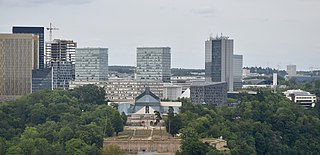
Luxembourg, also known as Luxembourg City, is the capital city of Luxembourg and the country's most populous commune. Standing at the confluence of the Alzette and Pétrusse rivers in southern Luxembourg, the city lies at the heart of Western Europe, situated 213 km (132 mi) by road from Brussels, 372 km (231 mi) from Paris, and 209 km (130 mi) from Cologne. The city contains Luxembourg Castle, established by the Franks in the Early Middle Ages, around which a settlement developed.

Kirchberg is a quarter in north-eastern Luxembourg City, in southern Luxembourg. It consists of a plateau overlooking the north-east of the historical city center, Ville Haute, connected to the rest of the elevated city by the Grand Duchess Charlotte Bridge, which spans the Pfaffenthal valley. It is often referred to, in reference to the geographical feature it inhabits, as the Kirchberg plateau by Luxembourgish residents. Kirchberg is the predominant location of the European Union institutions and bodies based within Luxembourg, and is sometimes used as a metonym for the EU's judiciary, which occupies the quarter. It is thus the central business district of Luxembourg.

The Duchy of Luxembourg was a state of the Holy Roman Empire, the ancestral homeland of the noble House of Luxembourg. The House of Luxembourg became one of the most important political forces in the 14th century, competing against the House of Habsburg for supremacy in Central Europe. They would be the heirs to the Přemyslid dynasty in the Kingdom of Bohemia, succeeding to the Kingdom of Hungary and contributing four Holy Roman Emperors until their own line of male heirs came to an end and the House of Habsburg received the territories that the two Houses had originally agreed upon in the Treaty of Brünn in 1364.

The first generation of trams in Luxembourg ran from 1875 to 1964, before being withdrawn from service and the tramways removed. A second generation of trams began operational service on 10 December 2017, along a new route that will, by early 2025, run from Luxembourg Airport to the Cloche d'Or business district, in Gasperich, serving the new national stadium, via Pfaffenthal-Kirchberg and Luxembourg railway stations. Additional lines are planned for the network both within Luxembourg City, as well as extending to Strassen and Esch-sur-Alzette.

The following is a timeline of the history of Brussels, Belgium.
The following is a timeline of the history of the city of Marseille, France.
The following is a timeline of the history of the municipality of Leuven, Belgium.
The following is a timeline of the history of the municipality of Ghent, Belgium.
The following is a timeline of the history of the municipality of Breda, Netherlands.
The following is a timeline of the history of the municipality of Nijmegen, Netherlands.
The following is a timeline of the history of the municipality of Liège, Belgium.
The following is a timeline of the history of the city of Mainz, Germany.
The following is a timeline of the history of the city of Ljubljana, Slovenia.
The following is a timeline of the history of the city of Metz, France.
The following is a timeline of the history of the city of Dijon, France.
The following is a timeline of the history of the city of Amiens, France.
The following is a timeline of the history of the city of Reims, France.
The following is a timeline of the history of the city of Caen, France.

Pfaffenthal-Kirchberg railway station is a rail station on CFL Line 10, in the north of Luxembourg City which opened in December 2017. It is located on Rue Saint-Mathieu in the Pfaffenthal valley, below the Grand Duchess Charlotte Bridge, overlooking the Alzette River. The Société Nationale des Chemins de Fer Luxembourgeois (CFL), the state-owned rail company, operates both the station and the associated funicular line, which links the station to the Kirchberg plateau.

The Pfaffenthal Panoramic Elevator is a public elevator in Luxembourg City, Luxembourg which connects the city quarters of Ville Haute, the historical city center, with Pfaffenthal, in the Alzette valley below. It offers its passengers panoramic views of the Alzette River valley. The Pfaffenthal elevator, together with the Grund public elevator, and the Pfaffenthal-Kirchberg funicular, form Luxembourg City's three cable transport modes connecting its elevated city with city quarters located in the Alzette and Petrusse river valleys.








